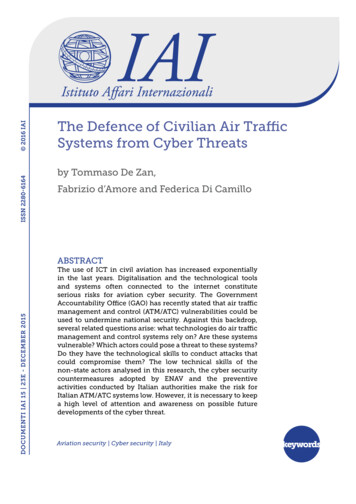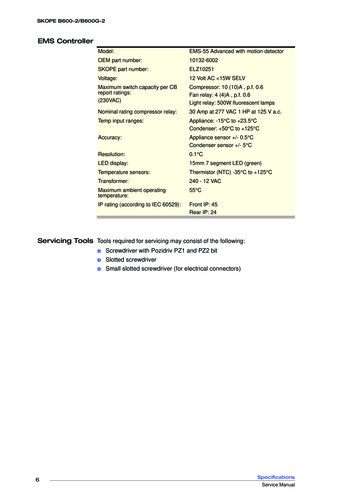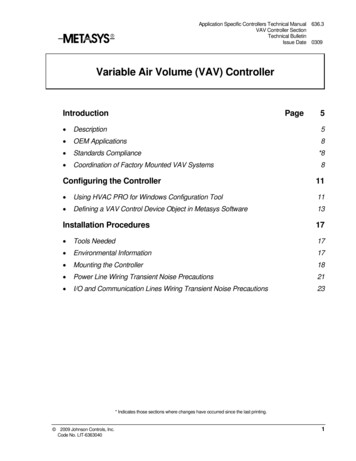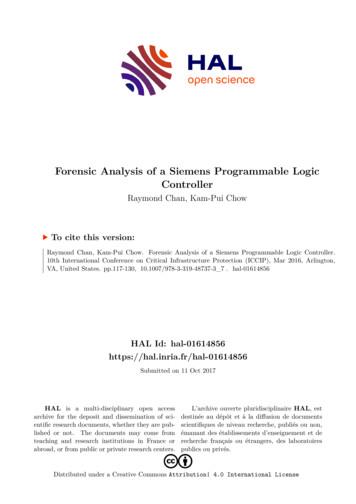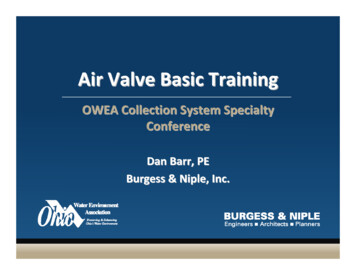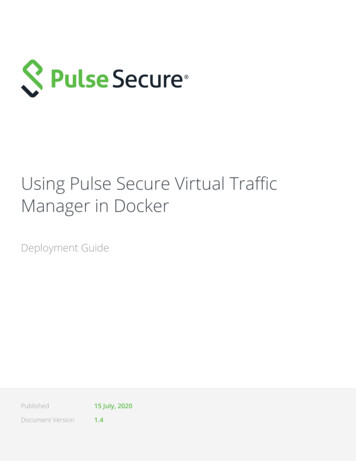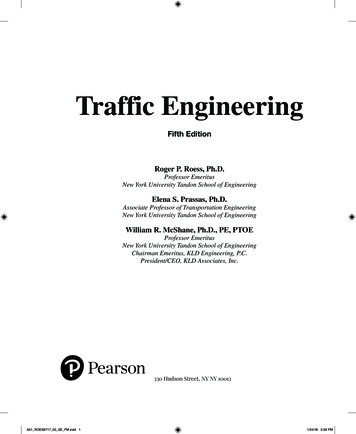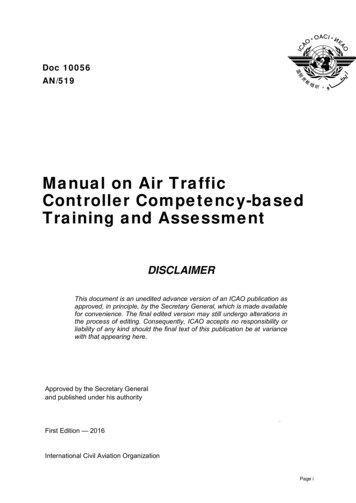
Transcription
Doc 10056AN/519Manual on Air TrafficController Competency-basedTraining and AssessmentDISCLAIMERThis document is an unedited advance version of an ICAO publication asapproved, in principle, by the Secretary General, which is made availablefor convenience. The final edited version may still undergo alterations inthe process of editing. Consequently, ICAO accepts no responsibility orliability of any kind should the final text of this publication be at variancewith that appearing here.Approved by the Secretary Generaland published under his authorityFirst Edition — 2016International Civil Aviation OrganizationPage i
ICAO DOC 10056AMENDMENTSAmendments are announced in the supplements to the Catalogue ofICAO Publications; the Catalogue and its supplements are available onthe ICAO website at www.icao.int. The space below is provided tokeep a record of such amendments.RECORD OF AMENDMENTS AND CORRIGENDAAMENDMENTSNo.Page iiDateCORRIGENDAEntered byNo.DateEntered by
ICAO DOC 10056CONTENTSFOREWORD .5GLOSSARY .6PUBLICATIONS .8Chapter 1 - Introduction .91.11.21.31.41.51.61.71.81.91.10General.9Status .9Intended users .9Structure of the manual .9Regulatory requirements .10Competency-based ATC training .13How to use this manual .18The instructional systems design model .19The step-by-step guide .19Pre-requisites for establishing competency-based training and assessment .24Chapter 2 – Design of competency-based training and assessment . 252.12.22.32.42.52.62.72.82.92.10General.25The components of competency-based training and assessment .25Overview of competency-based training workflows .26WORKFLOW 1: Analyse training need .27WORKFLOW 2: Design competency-based training and assessment .30WORKFLOW 2 - Part 1: Design the adapted competency model .30WORKFLOW 2 - Part 2: Design the assessment and training plans .34WORKFLOW 3: Develop the training and assessment materials .50WORKFLOW 4: Conduct the course .51WORKFLOW 5: Evaluate course .52Chapter 3 – Instructors and assessors. 533.13.23.33.43.5Introduction .53Practical instructing and assessing .53General requirements .53Instructors .54Assessors .55Chapter 4 – Initial training. 574.14.2Introduction .57Design considerations .57Chapter 5 – Unit Training . 655.15.2Introduction .65Design considerations .66Chapter 6 – Refresher Training . 716.16.2Introduction .71Design considerations .72Page iii
ICAO DOC 10056Chapter 7 – Conversion Training . 777.17.2Introduction .77Design considerations .78CHAPTER 2 - Appendix A – Example Training Specification .82CHAPTER 2 - Appendix B – Example Adapted Competency Model .85CHAPTER 2 - Appendix C – Example Evidence Guide .91CHAPTER 2 - Appendix D – Example Competency Checklist .94CHAPTER 2 - Appendix E – Example Competency Assessment Form .96CHAPTER 4 - Appendix 1a – Example Basic Training Syllabus .107CHAPTER 4 - Appendix 1d – Example Approach Control .271Surveillance Rating Syllabus .271CHAPTER 4 - Appendix 1e – Example Area Control Procedural .335Rating syllabus .335CHAPTER 4 - Appendix 1f – Example Area Control Surveillance .382Rating syllabus .382CHAPTER 4 - Appendix 2 – Example Training Events .430CHAPTER 6 - Appendix 1 – Training Benefits Analysis .435CHAPTER 6 - Appendix 2 – Example Refresher Training Syllabus .437CHAPTER 6 - Appendix 3 – Example of Training Event .446Page iv
ICAO DOC 10056FOREWORDThe next generation of aviation professionals (NGAP) initiatives were launched to ensure that enoughqualified and competent aviation professionals are available to operate, manage and maintain the futureinternational air transport system. In May 2009, the NGAP Task Force was created and was instrumentalin supporting the preparry work for the NGAP Symposium conducted at ICAO from 1 to 4 March 2010.Several outcomes were drawn from the first NGAP Symposium, among them:a) the need to develop regulatory frameworks that enable and support the use ofmodern training and learning technologies (competency-based training,evidence-based training and increased use of simulation) and that are not an obstacleto industry best practices; andb) the need to define competencies for all aviation activities affecting safety in order tofacilitate the free-flow of professionals through internationally agreed upon standardsand assessment practices.The effective performance of the air traffic management (ATM) system depends on competent andqualified air traffic management professionals. The ATM system is evolving towards a globally integratedand collaborative system. Air traffic controllers (ATCs) managing and operating this system must have ashared understanding of what is expected of them in terms of performance wherever they may work inorder to support a globally interoperable system and to achieve optimum capacity within acceptable safetylimits. This shared understanding becomes critical when considering the increasing traffic and the growingcomplexity and interconnectedness of the systems involved. As controller-pilot and s ystem-to-systeminterfaces evolve, the air traffic controllers managing and operating these systems need to share acommon reference to ensure seamless operations.In February 2015, procedures for the implementation of competency-based training and assessment forair traffic control officers (ATCOs) were included in the Procedures for Air Navigation Services — Training(PANS-TRG, Doc 9868). They provide States, air navigation service providers (ANSPs) and trainingproviders with guidance on how to structure their approach to training and assessment of controllers. Theprocedures provide a flexible framework that stakeholders can adapt to any local operational context andrequirement.Some of the provisions already included in the PANS-TRG are of a generic nature and can apply to allaviation functions including ATM personnel. The purpose of this manual is to provide additional guidanceto the provisions of the PANS-TRG and support stakeholders in the successful implementation ofcompetency-based training and assessment for ATCOs.Comments concerning the manual should be addressed to:The Secretary GeneralInternational Civil Aviation Organization999 Robert-Bourassa BoulevardMontréal, Québec Canada H3C 5H7Page 5
ICAO DOC 10056GLOSSARYDEFINITIONSAssessment(evidence) guideA guide that provides detailed information in the form of evidence that aninstructor or an evaluator can use to determine whether a candidate meets therequirements of the competency standard.CompetencyA combination of skills, knowledge and attitudes required to perform a task tothe prescribed standard.Competency-basedtraining andassessmentTraining and assessment that are characterized by a performance orientation,emphasis on standards of performance and their measurement, and thedevelopment of training to the specified performance standards.Competency elementAn action that constitutes a task that has a triggering event and a terminatingevent that clearly defines its limits, and an observable outcome.Competency unitA discrete function consisting of a number of competency elements.Performance criteriaSimple, evaluative statements on the required outcome of the competencyelement and a description of the criteria used to judge whether the requiredlevel of performance has been achieved.Range of variables(conditions)The conditions under which the competency units must be FKNOWLoAPage 6Area control proceduralArea control surveillanceAerodrome controlAnalyse, design, develop, implement, evaluateAeronautical information servicesAlerting serviceApproach control proceduralApproach precision radar controlApproach control surveillanceAir traffic controlAir traffic control officerAir traffic managementAir traffic servicesAerodrome traffic zoneCompetency elementCommunicationCoordinationController–pilot data link communicationsCompetency unitFlight information serviceHuman FactorsKnowledgeLetter of agreement
ICAO DOC SITUSPPSSRSTARTEAMTRAFTWRWORKManagement of non-routine situationsNormal operations safety surveysNon-routine situationsOn-the-job trainingProcedures for Air Navigation Services — Training (PANS-TRG, Doc 9868)Performance criteriaProblem solving and decision makingPrimary surveillance radarSite acceptance testSelf-management and continuous developmentSeparation and conflict resolutionStandard instrument departureSituational awarenessStandard practices and proceduresSecondary surveillance radarStandard instrument arrivalTeamworkTraffic and capacity managementTower (aerodrome control)Workload management————————Page 7
ICAO DOC 10056PUBLICATIONS(referred to in this manual)AnnexesAnnex 1 — Personnel LicensingAnnex 10 — Aeronautical Telecommunications, Volume II — Communication Procedures including thosewith PANS statusAnnex 11 — Air Traffic ServicesProcedures for Air Navigation Services (PANS)Procedures for Air Navigation Services — Training (PANS-TRG, Doc 9868)Procedures for Air Navigation Services — Air Traffic Management (PANS-ATM, Doc 4444)ManualsManual of Procedures for Establishment and Management of a State’s Personnel Licensing System(Doc 9379)Doc Safety Management Manual (SMM) (Doc 9859)Manual of Radiotelephony (Doc 9432)Regional Supplementary Procedures (Doc 7030)Manual on the Approval of Flight Crew Training Organizations (Doc 9841)Other PublicationsEUROCONTROL. Specification for the ATCO Common Core Content Initial Training. Edition 2.0.Brussels. EUROCONTROLEUROCONTROL. ATC Refresher Training Manual Edition 1.0. Brussels. EUROCONTROLOECD. The Definition and Selection of Key Competencies. 2005————————Page 8
ICAO DOC 10056Chapter 1 - Introduction1.1GeneralThis manual provides air traffic control approved training organizations (ATOs) and operational units withguidance on how to identify the air traffic controller competencies that are necessary for their environmentand then design the training and assessment that is needed for the various stages of air traffic controllerdevelopment.Air traffic controller development stages include initial training, the training that is essential for theperformance of control duties at operational units and the training that supports qualified air trafficcontrollers’ in maintaining their competence.Since it is well recognized that ICAO regions, Contracting States and operational air traffic control unitshave differing regulatory, operational, technical and organizational environments, this manual does notprescribe a “one-size-fits-all” training programme. Instead, it describes how ATOs and operational unitscan establish an adapted competency model that is appropriate for their specific environment.The manual is based on the knowledge, skill and experience requirements detailed in Annex 1 –Personnel Licensing and the ATC competency framework described in the Procedures for Air NavigationsServices – Training (PANS-TRG, Doc 9868).In recognition of the significant role played by the instructors and assessors in a competency-basedtraining system, guidance is provided on the various aspects of instructing and assessing in acompetency-based environment.1.2StatusThis manual provides guidance on how to design a local competency-based training and assessmentprogramme specifically for air traffic controllers. Implementation of competency-based training andassessment for air traffic controllers is optional. However, should the air navigation service providersand/or ATOs choose to implement such training, the relevant procedures in PANS-TRG, supported by thismanual, should be used.1.3Intended usersThis manual is aimed at personnel responsible for the design of ATC training. It includes:1.4a)designers who are creating a completely new training system; andb)designers who already have an established training system and who intend to evolvetheir system towards a competency-based approach.Structure of the manualThe manual consists of seven chapters.Chapter 1 provides an overview of the regulatory requirements for air traffic controller training, anoverview of competency-based training, the competency framework, the organization of ATC training andhow to use this manual.Chapter 2 describes, in detail, the step-by-step process for analysing and designing competency-basedtraining. This process may be used for the design of any of the phases of air traffic controller training.Since some of the fundamental aspects of successful competency-based training and assessment arecarried out during the “develop”, “conduct” and “evaluate” steps, this chapter also pays attention to thesePage 9
ICAO DOC 10056specific aspects. However, please note that for these last three steps, the chapter does not provide acomplete process as most of the information is of a more general nature and can be f ound in manyinstructional design documents. Only the aspects of ATC competency-based training and assessment thatare particular to these phases are highlighted.Chapter 3 describes the role of instructors and assessors in a c ompetency-based training andassessment environment.Chapters 4 to 7 cover the various phases of training (initial, unit, refresher and conversion training) andare complementary to Chapter 2. The content of these chapters corresponds with the components ofcompetency-based training and assessment that are discussed in Chapter 2. Each of these chapterselaborates the specifics of these components as they relate to a particular phase of training. Thesechapters also provide detailed examples to help the user understand the particulars of training duringeach phase.1.5Regulatory requirementsAnnex 1 – Personnel licensing categorises six air traffic controller ratings that may be endorsed on an airtraffic controller licence, or record. They are:a)aerodrome control (ADC) rating;b)approach control procedural rating (APP);c)approach control surveillance rating (APS);d)area control procedural rating (ACP);e)area control surveillance rating (ACS); andf)approach precision radar control rating (APRC).Annex 1 makes clear that before a person can be issued with an air traffic control licence, there are anumber of criteria that need to be met. Some of these criteria relate directly to the training of an air trafficcontroller. These include the knowledge, skills and practical experience requirements for all controllersand then the specific requirements for each of the ratings.There is a gen eral requirement that all air traffic controllers demonstrate knowledge in the following1subjects :Subject1Air lawRules and regulations relevant to the air trafficcontroller.Air traffic control equipmentPrinciples, use and limitations of equipment used inair traffic control.General knowledgePrinciples of flight; principles of operation andfunctioning of aircraft, engines and systems; aircraftperformance relevant to air traffic control operations.Human performanceHuman performance including principles of threatand error management.Annex 1, paragraph 4.4.1.2Page 10Description
ICAO DOC 10056SubjectDescriptionMeteorologyAeronautical meteorology; use and appreciation ofmeteorological documentation and information; originand characteristics of weather phenomena affectingflight operations and safety; altimetry.NavigationPrinciples of air navigation; principle, limitation andaccuracy of navigation systems and visual aids.Operational proceduresAir traffic control, communication, radiotelephony andphraseology procedures (routine, non-routine andemergency); use of the relevant aeronauticaldocumentation; safety practices associated withflight.In addition, Annex 1 states that the applicant shall have completed an approved training course in an2approved training organization and have undertaken on-the-job training for at least three months.Furthermore, Annex 1 then details the knowledge required by a controller for each category of air traffic3controller rating. In the case of the ADC rating, the knowledge required is listed below ;1. Aerodrome layout, physical characteristics and visual aids;2. Airspace structure;3. Applicable rules, procedures and source of information;4. Air navigation facilities;5. Air traffic control equipment and its use;6. Terrain and prominent landmarks;7. Characteristics of air traffic;8. Weather phenomena; and9. Emergency and search and rescue plans.4In the case of both the APP and ACP ratings, the knowledge required is listed below ;1. Airspace structure;2. Applicable rules, procedures and source of information;3. Air navigation facilities;4. Air traffic control equipment and its use;5. Terrain and prominent landmarks;234Annex 1, paragraph 1.2.8.3Annex 1, paragraph 4.5.2.1 a)Annex 1, paragraph 4.5.2.1 b)Page 11
ICAO DOC 100566. Characteristics of air traffic and traffic flow;7. Weather phenomena; and8. Emergency and search and rescue plans.5In the case of the APS, APRC and ACS ratings, the knowledge required is listed below ;1. Airspace structure;2. Applicable rules, procedures and source of information;3. Air navigation facilities;4. Air traffic control equipment and its use;5. Terrain and prominent landmarks;6. Characteristics of air traffic and traffic flow;7. Weather phenomena;8. Emergency and search and rescue plans;9. Principles, use and limitations of applicable ATS surveillance systemsand associated equipment; and10. Procedures for the provision of ATS surveillance service, asappropriate, including procedures to ensure appropriate terrainclearance.In the same manner as for the general requirements, Annex 1 states that applicants shall have completedan approved training course in an approved training organization and have undertaken a m inimum6number of hours of on-the-job training .Finally, the applicant for an air traffic control rating must be able to demonstrate that they have achievedthe necessary skill, judgement and performance that is required to provide a safe, orderly and expeditious7control service .Although the training and experience requirements are clearly detailed in Annex 1, there are norequirements or recommended practices on how the training should be organized. The only reference thatis made to the organization of training is that an applicant must complete an approved training course(s).Consequently, Contracting States, along with their ATOs and operational units, are able to structure andconduct their air traffic control training courses in a manner that is appropriate to their regulatory contextand their operational, technical and organizational environment.567Annex 1, paragraphs 4.5.2.1 b) and c)Annex 1, paragraphs 1.2.8.3 and 4.5.2.2.1Annex 1, paragraph 4.5.2.3Page 12
ICAO DOC 100561.61.6.1Competency-based ATC trainingWhat is competency?Competency-based training (and assessment) is a concept and methodology that was developed duringthe 1950s and became a mainstream concept sometime in the 1980s. Competency-based training hasbeen applied in many different contexts and professions and therefore, it is understandable that there aremany different definitions of what competence and competency-based training are. This sectionelaborates the competency concepts as they are used in this manual.Competency is a consistent dimension of human performance that is used to reliably predict successfulperformance on t he job. Competency is manifested and obs erved through behaviours that mobilize therelevant knowledge, skills and attitudes to carry out activities or tasks under specified conditions. A personsuccessfully achieves competency if its associated standard is met.Competencies allow people to formulate solutions for complex and/or difficult situations, including thosesituations that they are experiencing for the first time. For air traffic controllers, they need to be ab le todeal with these situations effectively and at the same time ensure that they are done in a safe and securemanner.1.6.1.1KnowledgeKnowledge is specific information required to enable a learner to develop and apply the skills and attitudesto recall facts, identify concepts, apply rules or principles, solve problems, and think creatively in thecontext of work.Knowledge is an outcome of the learning process. There are different types of knowledge: declarative(facts, raw data), procedural (categorized/contextualized, application of conditional if-then rules), strategic(synthesis, inference to guide resource allocation for decision-making, problem solving, behaviouralaction), adaptive (generalization, innovation, invention).1.6.1.2SkillSkill is an ability to perform an activity or action. It is often divided into three types: motor, cognitive andmetacognitive skills.A motor skill is an intentional movement involving a motor or muscular component, that must be learnedand voluntarily produced to proficiently perform a goal-oriented task.Cognitive skills are any mental skills that are used in the process of acquiring knowledge; these skillsinclude reasoning, perception, and intuition.Metacognitive skills relate to the ability of learners to monitor and direct their own learning processes(“thinking about thinking”). For example, planning how to approach a g iven learning task, monitoringcomprehension, and evaluating progress toward the completion of a task are metacognitive.Skills are developed over time and with practice. Often complex tasks that are new to the controller areinitially seen as cognitively demanding, however, as they become more practiced, some of these cognitiveprocesses become automatized and so the skill requires less effort to perform. In terms of air trafficcontrol, this automation gives the controller the capability and the capacity to find solutions to more difficultsituations.Page 13
ICAO DOC 100561.6.1.3AttitudeAttitude is a persisting internal mental state or disposition that influences an individual’s choice of personalaction toward some object, person or event and that can be learned. Attitudes have affective components,cognitive aspects and behavioural consequences. To demonstrate the “right” attitude, a learner needs toknow how to be in a given context.For air traffic controllers, their attitude towards issues such as safety, adherence to regulations, workingwith others and responsibility is a significant factor in the achievement of competence and the safety of airtraffic. Competence can only be observed through performance. However, it is not possible to directlyobserve all the different skills which contribute to competence, especially the cognitive skills; instead theyare inferred from observations of the controller performing tasks. For example, whilst observing theperformance of a trainee who is establishing an arrival sequence, it is not possible for the instructor todirectly observe whether the trainee has achieved an effective sequence through adequate planning andappropriate situation awareness or has achieved the sequence by reacting to events and chancecircumstances. However, after repeated observations of the trainee consistently achieving an effectivesequence, it is reasonable to assume that this is not being accomplished through chance and that theappropriate competencies have been acquired.1.6.2Developing competency-based trainingCompetency-based training and assessment makes use of a systematic approach whereby the air trafficcontroller’s competencies and their performance criteria are defined. The training programme is thenbased on those competencies that were identified and a process for assessment is developed to ensurethat the identified competencies have been achieved. In particular, the performance criteria can only beestablished by the approved training organization or air navigation service provider since the competencystandards are context-dependent.Competency-based training and assessment for air traffic controllers is generally delivered in threestages:’ basic training’ that is usually conducted only once, ‘rating training’ that is conducted once perrating and ‘unit training’ that is conducted once per specific unit, sector or group of sectors. Refreshertraining and assessment is conducted multiple times to ensure that competencies are maintained. Theremay be specific instances where additional training is required, such as training for system upgrades ortraining after a long period of time not working at an operational position.1.6.3BenefitsThe key benefits to organizations which implement a competency-based training programme include:a)Assurance that ATCOs can demonstrate sufficient expertiseA competency based approach ensures that trainees achieve a level of performancethat enables them to work independently and safely.b)On-going performance evaluation of operational personnelAn important feature of competency-based approaches is the identification andcollection of assessment evidence which supports decision-makers/managers inmonitoring the ongoing competence of operational staff.Page 14
ICAO DOC 10056c)Early identification o
Page i . Doc 10056 . AN/519 . Manual on Air Traffic Controller Competency-based Training and Assessment . DISCLAIMER . This document is an unedited advance version of an ICAO publication as
